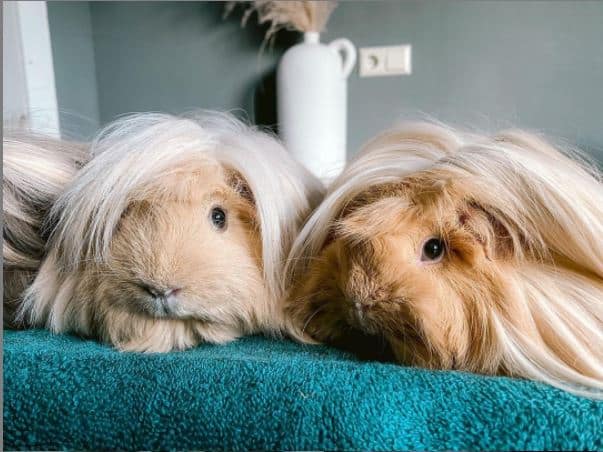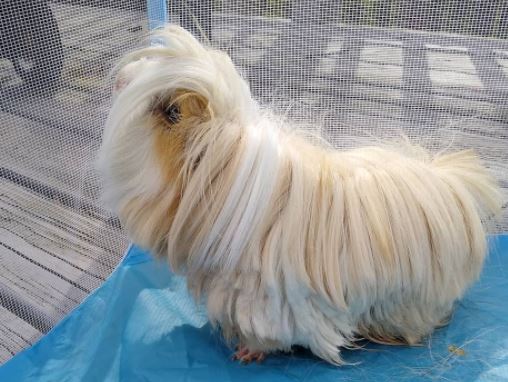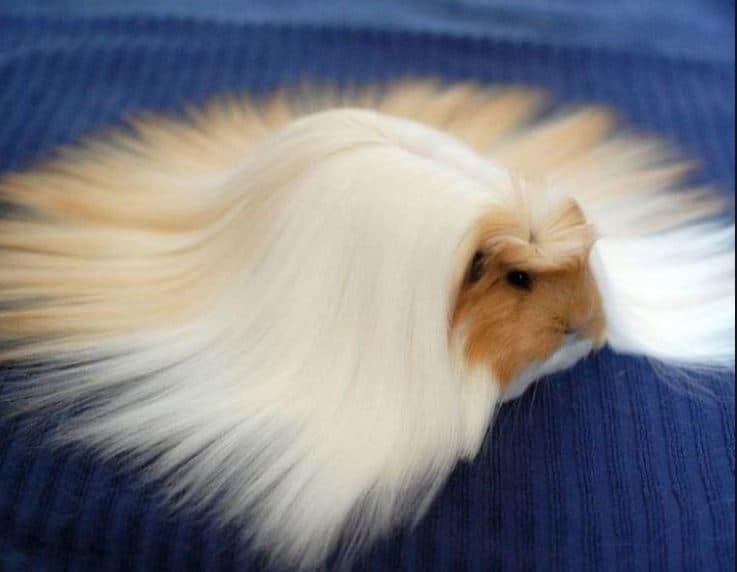The Peruvian guinea pig is a long-haired guinea pig breed. The Peruvian has the longest hair of all the guinea pigs. The reason why they have such long hair is because of an autosomal recessive gene. This gene makes it possible for their hair to grow to a length of over 50 centimeters. In fact, their hair is so long that they are incapable of properly grooming themselves. It is because of this that Peruvian guinea pigs are generally not recommended as a pet for beginners.
However, if you’re an experienced guinea pig owner, there are also a lot of benefits to owning a Peruvian guinea pig. Their long hair might make grooming them more difficult, but it does give them a very distinct and adorable look that many guinea pig fans fall in love with. Also, their kind, curious, and affectionate personality makes them great as pets.
If you’re considering taking a Peruvian guinea pig into your home you’ve come to the right place. Because today, we’re putting this breed in the spotlight. We’ll take a look at their appearance, their personality, their lifespan, how to care for them, how much they cost, and much more to give you the most complete overview possible of this beautiful breed.

Peruvian Guinea Pig Fact Sheet
| Name | Peruvian Guinea Pig |
| Coat | Long-haired, straight |
| Colors | Most commonly white, dark brown, light brown, and black |
| Lifespan | 5-8 years |
| Temperament | Curious, affectionate, intelligent |
| Size | Large; 10-14 inches |
| Diet | 80% hay, 20% vegetables, fruits, nuggets & other |
Peruvian Guinea Pig History

Despite their name, guinea pigs are not native to guinea (nor are they closely related to pigs). They’re originally from the Andes mountain range in South America where they graze on the grassy plains and forest edges in large herds. Guinea pigs have existed for thousands of years and humans started domesticating them as early as 5000 BC.
At first, humans domesticated guinea pigs as livestock to use them as a source of food. Much later, we started raising them as pets because we recognized that their affectionate nature and docile behavior made them excellent companions. This lead to breeding programs, which lead to the large variety of different guinea pig breeds we know today.
As the name suggests, the Peruvian Guinea Pig comes from Peru, and the reason why it’s so large is that there were research programs in Peruvian Universities, such as La Molina National Agrarian University, to create larger guinea pigs. The reason why they wanted to create larger guinea pigs is that while most countries do not eat guinea pigs, in Peru they still do, and larger guinea pigs naturally produce more meat. Even today, in Peru they eat an estimated 65 million guinea pigs every year!
Of course, other countries were interested in these guinea pigs as well. Not to eat them, but rather to keep them as pets, and that’s how the Peruvian guinea pig became a popular breed in the west. The Peruvian is widely recognized as a distinct breed by many organizations, such as the American Cavy Breeders Association and the British Cavy Council.
Peruvian Guinea Pig size & appearance
The Peruvian guinea pig’s most easily recognizable feature is its magnificently long hair. Their hair can grow over 20 inches in length and is naturally parted along the back, causing it to flow towards the floor, while the hair on their head grows forward over their face. They come in a large variety of different colors but are most commonly seen in white, dark brown, light brown, and black colorations. The Peruvian can also have two, or even three colors at once. This is called being Bicolor and Tricolor.
Furthermore, the Peruvian Guinea Pig is remarkably large. They grow to an impressive 10 to 14 inches in length. Male Peruvian guinea pigs weigh around 1000 to 1400 grams, while females weigh around 900 to 1200 grams. The reason why they are larger than other breeds is that they were specifically bred to be large because in Peru they’re used as a source of food.
take a look at this video to get a better idea of what exactly the Peruvian guinea pig looks like:
Peruvian Guinea Pig Lifespan
The typical lifespan of the Peruvian is about the same as that of other breeds – around 5 to 8 years. Of course, how long your Peruvian lives depends on many factors, such as their diet, their genetics, and how well they’re cared for. A healthy, well-fed, and properly cared for Peruvian can live much longer than 8 years. There are reports of guinea pigs that have lived well over 14 years, which is almost double the average life expectancy!
It’s important to know that Peruvians are capable of living so long because it’s something that you have to be prepared for. When you’re buying one of these beautiful animals you have to be ready to take care of it for many years to come – if you are not ready for such a long-term commitment, it might be better to consider adopting a different animal with a shorter lifespan like a pet rat or a hamster.
Peruvian Guinea Pig temperament
The temperament of the Peruvian guinea pig is often described as curious, affectionate, intelligent, and social. Unlike many other guinea pig breeds, the Peruvian is very well known for being an explorer, they love exploring their cage and their surroundings.

This breed enjoys being handled and petted by humans and can form strong bonds with its owners. They also get along well with other guinea pigs and other pets that you might have. In nature, guinea pigs roam in large herds, they truly are social animals and because of that, they need to have a companion. A Peruvian guinea pig that’s kept in solitude will not be happy. No matter how much love and attention you give it they need the companionship of other guinea pigs. Always make sure that they always have at least one other guinea pig living with them to prevent them from getting lonely. A lonely, unhappy guinea pig can show abnormal behavior and can even become aggressive.
Peruvian guinea pigs generally do not bite, unless they feel threatened or stressed and respond well to being trained. Because they are fairly intelligent they can learn many different tricks if they are tamed well.
Caring for Peruvian Guinea Pigs
Grooming
Peruvian guinea pigs are relatively high maintenance. Because they have such long hair, grooming them can be quite time-consuming. Grooming needs to be done frequently, ideally on a daily basis. It’s important that you do not neglect the grooming of your Peruvian because if you do, it can lead to bedding, fecal matter, and urine getting stuck in their coats which can lead to skin and health issues. Grooming your Peruvian is not particularly difficult but since it has to be done so frequently it will take up quite a bit of your time.
To groom your Peruvian Guinea Pig it’s recommended to use a soft brush and comb in the direction that their hair grows. That way you get rid of loose hairs and things that might be stuck in their long coat.
Further, it’s important that you cut their hair when it gets too long. When their hair grows past their feet and hits the floor, it’s time for a haircut. To cut their hair it’s recommended to give them a treat, such as a carrot, to keep them distracted. Then, take a piece of hair between your fingers and cut it off using a pair of scissors/shears. Be careful when doing this and do not cut too close to the skin to avoid injury.

Lastly, since Peruvians have such long hair they need to be bathed once every 1 to 2 months. For more information on how to bathe your guinea pig, check out this guide.
Diet
The diet of the Peruvian guinea pig is almost the same as that of other guinea pig breeds. These animals are herbivores, so make sure that you only feed them plant-based foods. Also, since Peruvians are larger than other guinea pig breeds they need more food than smaller breeds. The ideal diet for Peruvian consists of the following components:
- Unlimited supply of hay. High-quality hay, such as Timothy hay, should make up about 80% of their daily food intake. Timothy hay helps your Peruvian grind down their teeth and aids their digestion while containing very few calories. Make sure that they always have access to plenty of hay so that they can eat it whenever they feel like it.
- Commercial guinea pig nuggets/pellets. A small number of commercial nuggets/pellets on a daily basis can help your guinea pig get additional nutrition that it might lack from its regular diet.
- About a cup of fresh vegetables per day. About 20% of your Peruvian’s daily food intake (by weight) should come from fresh vegetables. Leafy greens such as kale, romaine lettuce, arugula, and spinach should make up the majority of their vegetable intake. A smaller amount should come from colored vegetables such as carrots.
- The occasional piece of fruit or other treats. Fruits are high in sugar, which means that guinea pigs should not eat too much fruit. However, the occasional piece of fruit as a treat is not harmful and can be beneficial because fruit contains a lot of nutrients. Make sure that no more than 10% of their daily food intake consists of fruit.
- Unlimited access to fresh, clean water from a water bottle. In order to stay hydrated, your Peruvian will need constant access to clean, fresh water. Make sure to renew the water in their bottle frequently so that they always have access to clean drinking water. Also, make sure that you wash the bottle frequently to avoid the build-up of bacteria.
One important thing to note when it comes to feeding your Peruvian is that it’s recommended to introduce your cavy to new foods slowly. If you’re introducing a new food into their diet (a piece of tomato for instance) you have to give them a small piece at first so that their digestive system can get used to it. If they eat too much of a new food at once it can lead to diarrhea.
Cost
Peruvian Guinea pigs are relatively easy to find. They’re not a particularly rare breed, which makes them quite cheap to buy. On average, expect to pay around $20-$30 for a Peruvian. Of course, the price does depend on your location and whether you buy from a breeder or a pet shop. I recommend that you buy one from a reputable breeder rather than a pet shop because breeders often have healthier and better cared for animals for sale than pet shops.
If you can’t find one at a breeder I recommend that you check out a local shelter. Peruvians are often found at shelters and getting one from a shelter means that you’re giving an abandoned piggy a loving new home, which is always a good thing to do. It’s often cheaper as well.

Final words
So, now you know everything there’s to know about the Peruvian guinea pig. You’ve learned about their history, where they come from, what they look like, how to groom them, what they like to eat, and much more! The Peruvian is an excellent choice for people who are looking for a long-haired breed due to their affectionate, curious, and intelligent temperament but you have to be aware that they’re much higher maintenance than short-haired breeds.
If you’re willing to put in the work to keep them well-groomed and properly cared for I’m sure that you will be very happy with this lovable breed and that you will become best friends in no time!
If you’re interested in learning more about other guinea pigs, I’ve written guides about the following breeds as well:
- How Long Do American Eskimo Dogs Live? Important Factors and Care Tips - September 29, 2023
- Do American Bulldogs Need Grooming? Essential Tips and Care Guidelines - September 29, 2023
- Do Bengal Cats Enjoy Playing? Essential Tips for Keeping Them Active - September 29, 2023